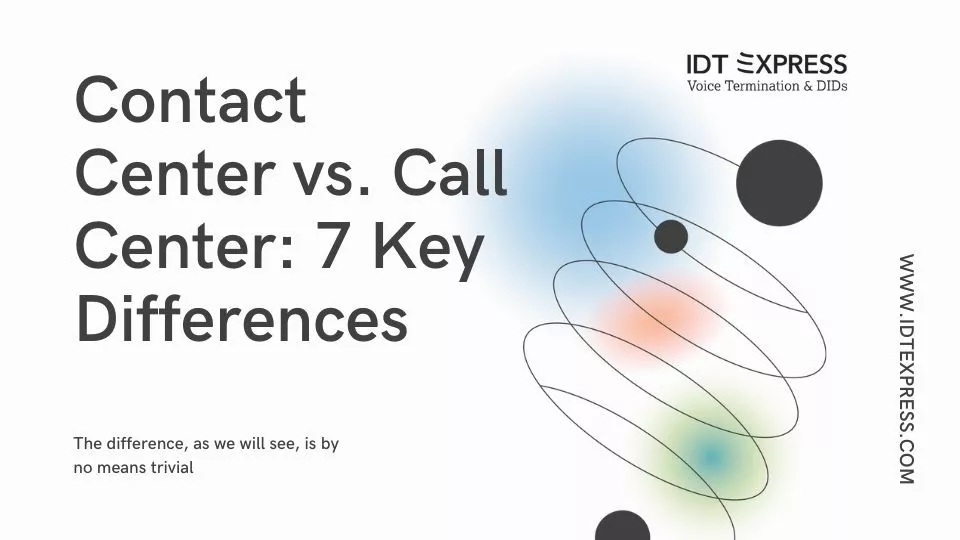Customer-oriented businesses need to be able to connect with their customers in a meaningful way. Decades ago, the only method of customer communication was via the telephone. This is why even as early as the 1970s, call centers were established to efficiently deal with customer queries, problems, and requests made over the phone via specially trained telephone operators. Over the years and decades, the call center evolved into what is known today as a contact center.
What, in essence, is the real difference between a call center and a contact center beyond simple semantics? The difference, as we will see, is by no means trivial. In actual fact, the distinction between the two is fundamental and extremely important for today’s businesses.
What is a Call Center?
In its most basic form, a call center is composed of a bank of phones and an automatic call distributor. Incoming calls from customers are distributed to idle phones using a particular algorithm to ensure as equal a distribution as possible. Operators answer phones and serve customers as needed.

Often, operators have computers available to them with various programs and software that allow them to serve the callers and respond to their queries. Call centers can get quite large employing dozens, hundreds, or even thousands of operators in some cases.
Technological Evolution of Call Centers
Over the years, call centers have improved in their technological development. Additional features and mechanisms such as interactive voice response (IVR), computer telephony integration (CTI), and dual-tone multiple-frequency (DTMF) or touchtone recognition have improved their operation drastically. However, even with these innovations, communication was still confined to the telephone itself. This is why it is still called a call center since its operation is focused on and around a telephone call.
The implementation of call centers employs more traditional telephony systems leveraging technologies such as ISDN and delivering services via proprietary PBXs and call distribution systems. Although they are relatively advanced, they are often monolithic in nature, difficult to modify or upgrade, and quite expensive to implement.
What is a Contact Center?
It is important to note that the contact center is not simply another evolutionary step in the advancement of the call center. It is in essence a whole different entity. The contact center, although based on the call center’s operation, is not limited by the telephone. Contact centers take advantage of what is known as network convergence, where voice and data share the same underlying network infrastructure, allowing them not only to coexist on the same network but also to be deeply integrated in their operations.
Along with network convergence, call centers have shifted from a hardware-based towards a more software-based implementation, allowing such systems to take advantage of things like virtualization and cloud-based services.

[Image source: jodochat.com]
Contact centers use this network convergence among other innovations, to deliver highly innovative, flexible, modifiable, and customizable systems and services. “How?” you may ask. Well, I believe the best way to describe these advantages is to examine seven key differences between these two entities.
Seven Key Differences Between Call Centers and Contact Centers
1. A Contact Center Uses Multiple Communication Channels
No longer confined only to the telephone, a modern contact center will allow agents to respond to queries and requests via multiple channels. These can include voice, video, instant messaging, text messages, email, or social media. Direct video or voice communication with agents can even take place via specially designed web pages by simply using a browser rather than calling in using a telephone. Alternatively, the use of mobile apps can also enable such direct and integrated interactions.

As more and more channels of communication become available, these can easily be integrated into contact center systems. For example, IDT’s uContact natively delivers communication capabilities via SMS text messages. And with the addition of Application Programming Interfaces (APIs) which we’ll talk about shortly, a whole series of highly customized communication channels can be developed and employed.
According to Nextiva, 48% of customers expect a response to questions and complaints via social media channels within 24 hours. Additionally, it is younger customers that are driving this trend, and thus, the trend is only expected to increase over the coming years.
2. A Contact Center Leverages APIs to Integrate with other Services
APIs can be thought of as a software interface that defines a methodology of communication between computer programs. APIs allow software developers to enable deep interaction and integration between two software entities. By making information about the API publicly available, other software developers can enable interaction between their own software and that of third parties.
Practically, this means that an API-enabled contact center can interact with various business applications including customer resource management (CRM) platforms such as SalesForce, or helpdesk ticketing software such as Zendesk. In such cases, an incoming caller need not spend the time explaining who they are, what products or services they subscribe to, and what their problem or query is. Integrated CRM and helpdesk platforms will immediately inform the agent on their computer screen about the detailed history of the caller, making the time to resolution per call much shorter. More on these enhancements shortly.
API integrations can be quick and superficial or can be deep and involved. They can use preconfigured functionality or can be developed by an in-house or hired software development team. Their customizability and parameterization are unlimited and depend completely upon the desired functionality. Note that uContact enables the integration of 3rd party solution or application using APIs to enhance its operation.
3. A Contact Center Enhances the Efficiency of the Agent
Using these APIs as well as natively available functionality, contact center agents can receive a very rich amount of information on their screens that allows them to quickly serve callers. Customer details, call history, and related helpdesk tickets are just some of the information that can dynamically be presented to agents when a call comes in. This can be done either via the caller’s caller ID or via some identification number the user is prompted to provide while calling in.

In addition, a single agent can respond to multiple channels of communication, via their contact center software. Email, voice, video, and text messages can all be responded to from a single interface, in succession, allowing an agent to manage their own time in responding to customers via these multiple channels.
4. A Contact Center Delivers Agent Mobility
Unlike a legacy call center, where operators were tied to their telephones, modern contact centers allow agents to perform their duties from anywhere where there is a reliable internet connection. Contact center agent software is typically installed on a PC or laptop computer, via which all communication takes place. Agents may also have multiple instances of their agent software installed on their desktop, laptop, and mobile device, allowing them to respond from any device they choose. This gives agents a more fluid and flexible way of performing their jobs.
An example of this is uContact’s native support of WebRTC allowing agents to work from anywhere with equal agility. This is also very advantageous for employers, as it reduces the cost of agent housing facilities, and increases the size of the talent pool of potential agents, allowing them to employ workers from literally anywhere in the world!
5. A Contact Center Leverages VoIP Technology
Voice over IP (VoIP) has been around for almost two decades, but it is only in the last five years that it has become truly ubiquitous. Although not exclusively a contact center technology, VoIP has arguably been one of the most influential technological advancements that have affected contact centers. It is the primary reason behind the network convergence that has made contact centers possible. VoIP delivers voice communications using the Session Initiation Protocol (SIP), allowing integration with any SIP-based telephony carriers, as can be seen from uContacts’s contact center, as well as enabling the agent mobility mentioned before.
6. A Contact Center Leverages AI to Resolve Customer Issues More Quickly
Contact centers have recently been able to leverage the advancements of artificial intelligence (AI) to alleviate some of the more tedious tasks that agents have to deal with. Using speech recognition, or agent-bots responding to online text messages, AI can be trained to deal with simple and common issues that customers need. They are also helpful in understanding the need of the customer so that they can be put in contact with the appropriate human agent that will deal with their problem in the most skilled way. This is an area that is rapidly expanding and is expected to reach new levels in the coming months and years.

7. A Contact Center is Flexible and Easily Expandable
One of the greatest limitations of call centers is their lack of flexibility. Traditional telephony technology is notoriously difficult and expensive to modify, expand, and upgrade. Contact centers have a phenomenal level of flexibility and almost a fluidity in their offerings. With cloud-based architectures, software-based activation of services, easy-to-use, and intuitive management interfaces, as well as an enormous number of highly granular features and services, they can be highly customizable to fit the needs of any business. In addition, they can be deployed, upgraded, or expanded in literally a matter of minutes.
Conclusion
Even with these highly distinctive differences between call centers and contact centers, you will still find that these terms are often used interchangeably. Even so, contact centers are clearly different, much more agile, functional, and practical in today’s unpredictable and fast-paced business environment. Knowing these differences, and understanding their impact on a business, is of extreme importance for any network engineer or telecom specialist employing such services.




